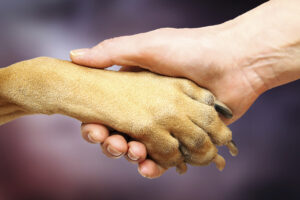
The idea of limb amputation is worrying for any pet owner, but sometimes it’s a necessary last resort to save your pet’s life.
One of the things no one wants to face when it comes to a beloved pet is the possibility of needing limb amputation. While veterinarians and board-certified veterinary surgeons will do everything they can to avoid this scenario, it is sometimes the only option left that will offer the relief and quality of life that your loved one deserves.
What are some of the reasons pets end up needing limb amputation?
There are a lot of different reasons why your veterinarian or board-certified veterinary surgeon might recommend amputation over other forms of treatment. Some of the more common issues that result in amputation include, but are not limited to:
- Cancer
- Severe trauma
- Birth defect
None of these issues are guaranteed to require amputation. In most cases, amputation is used as a last resort due to extensive damage or problems that are challenging to mend through surgery. If surgery would be overly risky or simply does not offer the necessary relief, amputation may have to be considered. Every instance is different, and the determination is made on a case-by-case basis with a lot of various factors in play that inform the decision of your veterinarian or board-certified veterinary surgeon.
Is there an alternative?
If amputation is recommended, it’s usually because it’s the best possible option for your companion. However, while most amputations are done where the limb meets the body (full amputation), partial amputations can be an option.
Partial amputation with prosthetics has become more popular in recent years, and it’s understandable why some owners would prefer this option. According to the American College of Veterinary Surgeons (ACVS), however, it is important to note that these can run the risk of further damage and pain to the affected limb. In addition, they warn that partial amputations with prosthetic limbs require daily care for the remainder of the pet’s life. This can be a lot of stress for both the pet and the owner, so it’s something that should be considered very carefully.
How do I care for a pet with an amputated limb?
On average, pets that have undergone amputation are released back to their home after a week. This timeframe will depend on your little one and how well they do after their surgery. Recovery time is usually around 4 weeks, but this could also vary depending on your pet and their circumstances. The best practice is always to rely on your veterinarian’s recommendations and follow their aftercare plan.
Giving your pet support and allowing them to adjust to the change will take time and patience. Hind leg amputees have an easier time adjusting, while foreleg amputees may take longer as they need to adjust their walk more significantly.
One important thing to remember, according to the ACVS, is to keep your pet on the lighter side of their normal weight for the remainder of their life. They have one less leg to stand on, which can mean orthopedic problems in the remaining limbs if the pet becomes too heavy.
Trust Maryland Veterinary Surgical Services With Your Companion’s Health
Your companion’s health is important, and the team at MVSS is ready to provide the best care possible for your furry family. We are dedicated to combining comprehensive exams and assessments with informative and honest discussions of your companion’s care. Once we have worked with you to decide on the best course of action for your dog, our professionals will use their surgical expertise to work towards the goal of giving your companion an active and pain-free life. We are proud to serve loyal companions in Catonsville and Baltimore. To learn more about our services, give us a call at 410-788-4088 or visit us online. For more information and tips for pet health, follow us on Facebook and Pinterest.
